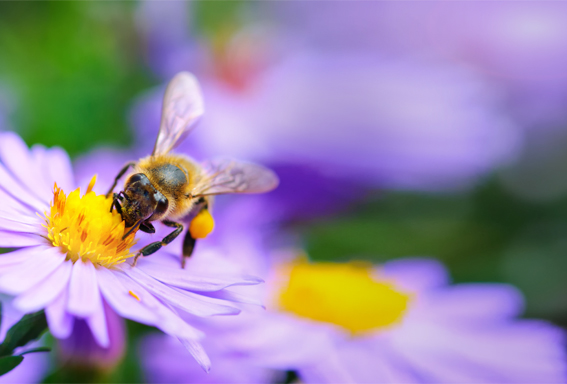Do one of the following:
- Open a photo in Photoshop Elements.
- Select a photo from the Photo Bin.
The Guided mode provides you with guided edits - a wizard-like interface to accomplish certain predefined effects. Each guided edit has an associated image. As you move the mouse horizontally over the image, the portion to the left of the slider displays the image before the effect is applied. The portion to the right of the slider displays the image after the effect is applied.
Create stylized text for shareworthy posts using the ADD TEXT guided edit. Align text horizontally, vertically, or on a path or a shape. Warp it and style it with gradients and patterns.

Try it in the app
Create stylized texts for your posts in Photoshop Elements.
Follow these steps to use this guided edit:
Do one of the following:
Select Guided mode > Basics > ADD TEXT.
From the right panel, select one of the following Type tools:
Learn more about the technique of using the Advanced Type Tools.


You can explore various formatting options, such as fonts, font styles, sizes, colors, leading, tracking, and text alignment, available within the Tool Options panel.
Warp text by selecting the Create warped text ![]() icon from the action bar and further customize the text by setting the desired Style, Bend, Horizontal Distortion, and Vertical Distortion from the Warp Text dialog box.
icon from the action bar and further customize the text by setting the desired Style, Bend, Horizontal Distortion, and Vertical Distortion from the Warp Text dialog box.
Learn more on how to warp text
Add a text style consisting of shadow, bevel, and stroke.


You can further customize the text style in the Style Settings panel basis your specific requirements by selecting the Advanced button.
Add Gradient or Pattern to your text to make it more appealing.




After you get the desired result, select Next to choose how you would like to proceed:
Allows you to perform quick selection to enter the text around the boundary of the quick selection.
Follow these steps to use the Text on Selection tool:
Select the Text on Selection type tool.
Drag the cursor over the photo to select the area where you would like to add the text.
Use square brackets [ ] to increase and decrease the size of the selection tool.
Select the Commit current operation button to confirm the selection.
Hover the mouse pointer over the boundary of the selected area until the Text on Selection type tool icon changes to the Type tool icon, and click over the boundary to get the reference text over the selected area. Start typing to add the desired text. You can further modify the reference text basis your requirements.
Select the Commit current operation button to save the text and the Cancel current operation button to undo the changes.
Allows you to enter the desired text around the boundary of a custom shape drawn over the image.
Follow these steps to use the Text on Shape tool:
Select the Text on Shape type tool.
Within the Tool Options, select the desired custom shape that you’d like to use to add the text. Drag the cursor on the image to create the shape.


Hover the mouse pointer over the boundary of the selected shape until the Text on Shape type tool icon changes to the Type tool icon, and click over the boundary of the chosen shape to get the reference text over the selected shape. Start typing to add the desired text. You can further modify the reference text basis your requirements.
Select the Commit current operation button to save the text and the Cancel current operation button to undo the changes.
Allows you to enter the desired text around the boundary of a custom path drawn over the image.
Follow these steps to use the Text on Path tool:
Select the Text on Path type tool.
Draw the path on the photo over which you’d like to add the text.
Select the Commit current operation button to confirm the path.
Hover the mouse pointer over the drawn path until the Text on Path type tool icon changes to the Type tool icon, and click over the boundary of the path to get the reference text over the selected area. Start typing to add the desired text. You can further modify the reference text basis your requirements.
Select the Commit current operation button to save the text and the Cancel current operation button to undo the changes.
MOVE & SCALE OBJECT guided edit enables you to select an object and change its position, size, and more—so that you can make your creation look exactly how you want.

The OBJECT REMOVAL guided edit enables you to remove unwanted content from your photos.

Here's how:
Do one of the following:
Select Guided mode > Basics > OBJECT REMOVAL.
From the right panel, select the Brush tool to paint over the object you want to remove. You can adjust the size of the brush using the Brush Size slider.
Select the following buttons to edit your selection:
Select Remove Object to remove the selected object in your photo.
To fine-tune your result, select Clone Stamp Tool to edit a large area. Once you choose this tool, hover over the part of the photo you want to cover the object with and press Alt+click (Windows)/Option+click (macOS). Select and drag the tool over the object. You can adjust the size of the brush with the Brush Size slider.
After you get the desired result, select Next and choose how you'd like to proceed:
Use the BRIGHTNESS AND CONTRAST guided edit to adjust brightness or contrast in an image.
You can view the after image only or view both the before and after images either vertically or horizontally.
Learn more about the technique of Adjusting shadows and light.
Use the CORRECT SKIN TONE guided edit to correct skin tones (tan, blush, and light) in an image.
You can view the after image only or view both the before and after images either vertically or horizontally.
Learn more about the technique to Adjust the color of skin tone.
Use the CROP PHOTO guided edit to crop an image.
You can view the after image only or view both the before and after images either vertically or horizontally.
Learn more on how to perform the Cropping operation.
Learn more About Levels adjustments.
Use the LIGHTEN AND DARKEN guided edit to lighten or darken an image.
You can view the after image only or view both the before and after images either vertically or horizontally.
Learn more about the technique of Adjusting shadows and light.
Use the RESIZE YOUR PHOTO guided edit to quickly create a version of your photograph to meet specific size requirements - pixels, inches, or bytes.
Select a photo from the Photo Bin, and select Guided > Basics > RESIZE YOUR PHOTO guided edit.
Identify the purpose of the resized photo. Choose whether you want to use it online or create a printed copy.
Web output: Select a size option from the drop-down.
Print output: Select a dimension option from the drop-down.
Select Next and then choose what to do with the output.
In the previous step, if you had opted for Web output, you're presented with the following options:
In the previous step, if you choose Print output, you're presented with the following options:
Select Done.
Use the ROTATE AND STRAIGHTEN guided edit for rotating a picture in 90-degree increments or drawing a line through an image to realign it.
You can view the after image only or view both the before and after images either vertically or horizontally.
Learn more on how to Rotate or flip an item.
Learn more on how to Straighten an image.
Use the SHARPEN guided edit to improve the clarity of an image. You can view the after image only or view both the before and after images either vertically or horizontally.
Learn more on how to Sharpen an image.
Treat your photo with the vignette effect to emphasize the importance of a person, group, or object, at the center of the photograph.


Open the desired photo. Select Guided mode > Basics > VIGNETTE EFFECT.
Select Black or White, to specify the color of the vignette you want to apply.
Use the Intensity slider to specify how intense (dark or light) you want the vignette to be.
Select Refine Shape to fine-tune the edge (Feather slider) and size (Roundness) of the vignette. For the Feather slider, a smaller pixel value indicates a harder, sharper edge, whereas a larger value indicates a softer, thicker edge.
For the Roundness slider, negative values cause an exaggerated vignette effect, and positive values cause a less visible vignette.
After you get the desired result, select Next to choose how you would like to proceed:
Easily edit and share images with Photoshop Elements
Combine photos, swap out colors, and erase anything with AI-powered tools.